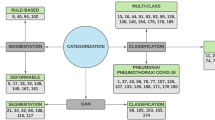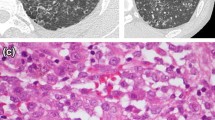Abstract
Purpose
The major hurdle for three-dimensional display of lung lobes is the automatic recognition of lobar fissures, boundaries of lung lobes. Lobar fissures are difficult to recognize due to their variable shape and appearance, along with the low contrast and high noise inherent in computed tomographic (CT) images. An algorithm for recognizing the major fissures in human lungs was developed and tested.
Methods
The algorithm employs texture analysis and fissure appearance to mimic the way that surgeons/radiologists read CT images in clinical settings. The algorithm uses 3 stages to automatically find the major fissures in human lungs: (a) texture analysis, (b) fissure region analysis, and (c) fissure identification.
Results
The algorithm’s feasibility was evaluated using isotropic CT images from 16 anonymous patients with varying pathologies. Compared with manual segmentation, the algorithm yielded mean distances of 1.92 ± 2.07 and 2.07 ± 2.37 mm, for recognizing the left and right major fissures, respectively.
Conclusions
An automatic recognition algorithm for major fissures in human lungs is feasible, providing a foundation for the future development of a complete segmentation algorithm for lung lobes.
Similar content being viewed by others
References
American Lung Association (2008) Lung disease data: 2008. American Lung Association, New York
Hemminger BM, Molina PL, Egan TM, Detterbeck FC, Muller KE, Coffrey CS, Lee JK (2005) Assessment of real-time 3D visualization for cardiothoracic diagnostic evaluation and surgery planning. J Digit Imaging 18: 145–153
Kuhnigk J-M, Dicken V, Zidowitz S, Bornemann L, Kuemmerlen B, Krass S, Peitgen H-O, Yuval S, Fend H-H, Rau WS, Achenbach T (2005) New tools for computer assistance in thoracic CT part 1. Functional analysis of lungs, lung lobes, and bronchopulmonary segments. Radiographics 25: 525–536
Hayashi K, Aziz A, Ashizawa K, Hayashi H, Nagaoki K, Otsuji H (2001) Radiographic and CT appearances of the major fissures. Radiographics 21: 861–874
Webb WR, Muller NL, Naidich DP (2001) High-resolution CT of the lung, 3rd edn. Lippincott, Williams and Wilkins, Philadelphia
Raasch BN, Carsky EW, Lane EJ, O’Callaghan JP, Heitzman ER (1982) Radiographic anatomy of the interlobar fissures: a study of 100 specimens. AJR 138: 554–647
Kass M, Witkin A, Terzopoulos D (1987) Snakes: active contour models. Int J Comp Vis v1: 321–331
Malladi R, Sethian JA, Vemuri BC (1995) Shape modeling with front propagation: a level set approach. IEEE Trans Pattern Anal Mach Intell 17: 158–175
Kuhnigk JM, Hahn HK, Hindennach M, Dicken V, Krass S, Peitgen H-O (2003) Lung lobe segmentation by anatomy-guided 3-D watershed transform. Proc SPIE (Med Imag) 5032: 1482–1490
Ukil S, Reinhardt JM (2009) Anatomy-guided lung lobe segmentation in X-ray CT images. IEEE Trans Med Imaging 28: 202–214
Zhou X, Hayashi T, Hara T, Fujita H, Yokoyama R, Kiryu T, Hoshi H (2006) Automatic segmentation and recognition of anatomical lung structures from high-resolution chest CT images. Comput Med Imag Graph 30: 299–313
Saita S, Kubo M, Kawata Y, Niki N, Ohmatsu H, Moriyama N (2006) An algorithm for the extraction of pulmonary fissures from low-dose multislice CT images. Syst Comput Jpn 37: 63–76
Van Rikxoort EM, Ginneken B, Klik M, Prokop M (2008) Supervised enhancement filters: application to fissure detection in chest CT scans. IEEE Trans Med Imaging 27: 1–10
Van Rikxoort EM, Prokop M, Hoop B, Viergever MA, Pluim JPW, Ginneken B (2010) Automatic segmentation of pulmonary lobes robust against incomplete fissures. IEEE Trans Med Imaging 29: 1286–1296
Kubo M, Niki N, Eguchi K, Kaneko M, Kusumoto M (2000) Extraction of pulmonary fissures from thin-section CT images using calculation of surface-curvatures and morphology filters. In: Proceedings of the IEEE international conference on image processing. pp 637–640
Zhang L, Hoffman EA, Reinhardt JM (2006) Atlas-driven lung lobe segmentation in volumetric X-ray CT images. IEEE Trans Med Imaging 25: 1–16
Wang J, Betke M, Ko JP (2006) Pulmonary fissure segmentation on CT. Med Image Anal 10: 530–547
Pu J, Leader JK, Zheng B, Knollmann F, Fuhrman C, Sciurba FC, Gur D (2009) A computational geometry approach to automated pulmonary fissure segmentation in CT examinations. IEEE Trans Med Imaging 28: 710–719
Wei Q, Hu Y, Gelfand G, Macgregor JH (2009) Segmentation of lung lobes in high-resolution isotropic CT images. IEEE Trans Biomed Eng 56: 1383–1393
Aykac D, Hoffman EA, McLennan G, Reinhardt JM (2003) Segmentation and analysis of the human airway tree from three-dimensional X-ray CT images. IEEE Trans Med Imaging 22: 940–950
Tschirren J, Hoffman EA, McLennan G, Sonka M (2005) Intrathoracic airway trees: segmentation and airway morphology analysis from low-dose CT scans. IEEE Trans Med Imaging 24: 1529–1539
Wei Q, Hu Y (2009) A study on using texture analysis methods for identifying lobar fissure regions in isotropic CT images. In: 31st annual international conference of the IEEE EMBS. pp 3537–3540
Anderson JA (1995) An introduction to neural networks. MIT Press, Cambridge
Nguyen D, Widrow B (1990) Improving the learning speed of 2-layer neural networks by choosing initial values of the adaptive weights. Proceedings of the international joint conference on neural networks, vol 3. 21–26
Galloway M (1974) Texture analysis using gray-level run lengths. Comput Graph Image Proc 4: 172–199
Sonka M, Hlavac V, Boyle R (2008) Image processing, analysis, and machine vision, 3rd edn. Thomson Learning, Toronto
Aziz A, Ashizawa K, Nagaoki K (2004) High resolution CT anatomy of the pulmonary fissures. J Thorac Imaging 19: 186–191
Tabachick BG, Fidell LS (2006) Experimental designs using ANOVA. Buxbury Press, Pacific Grove
Bland JM, Altman DG (1986) Statistical methods for assessing agreement between two methods of clinical measurement. Lancert I: 307–310
Author information
Authors and Affiliations
Corresponding author
Rights and permissions
About this article
Cite this article
Wei, Q., Hu, Y., MacGregor, J.H. et al. Automatic recognition of major fissures in human lungs. Int J CARS 7, 111–123 (2012). https://doi.org/10.1007/s11548-011-0632-y
Received:
Accepted:
Published:
Issue Date:
DOI: https://doi.org/10.1007/s11548-011-0632-y




